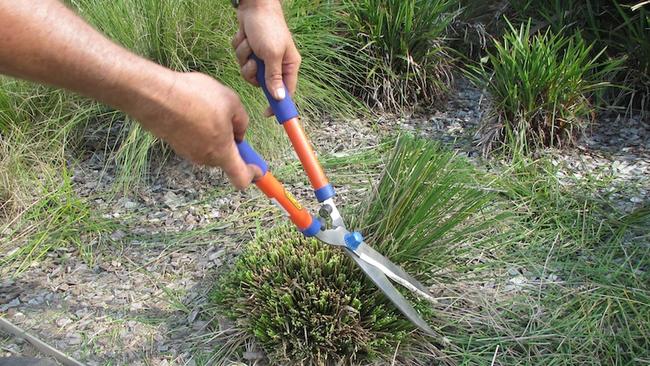Spring gardening: once-a-year pruning of ornamental grasses
Ornamental grasses will stay fresh and vibrant with a savage “boy prune” in late winter or early spring.

After the respite from mowing during winter, cutting the grass is now on the jobs list. I’m talking about the once-a-year prune of ornamental grasses and tufting plants such as foxtail grass (Pennisetum), Miscanthus, Poa, native flax lily (Dianella) and lily turf (Liriope).
Increasingly popular in contemporary garden design, mass-planted grasses offer contrasting textural qualities, seasonal interest, wonderful movement in the wind, seeds or berries for birds, and most are low maintenance throughout the year.
But to keep ornamental grasses fresh and vibrant an annual prune is recommended in late winter or early spring.
This is a “boy prune”, a savage swipe that cuts back the clumps close to the base, removing the bulk of tatty and congested foliage from the previous year. Doing this makes way for the surge of fresh growth that emerges with the warm weather.
By summer, clumps are full size again but look much fresher and cleaner.
Anne King, an avid gardener and blogger, has worked out the fastest way to deal with the large swathes of ornamental foxtail grass in her Scotsburn, Victoria garden and has posted a helpful video with her blog at gardendrum.com.
Her Grasses Chainsaw Massacre is bound to excite chainsaw-wielding partners who are otherwise disinterested in the finer arts of garden maintenance.
Spoiler alert: elastic rope is used to loop around each clump, forming an erect ponytail, the base of which is a cinch to slide the chainsaw through.
Purple foxtail grass (Pennisetum ‘Rubrum’) is in many home gardens, planted for its dramatic burgundy foliage and the fat furry plumes that invite patting.
Left unpruned it becomes messy and sad, but removing the old faded foliage lets the lustrous new growth shine through.
The mass of dried grassy material produced from renovation pruning can be used as mulch, although sparingly, as too thick a layer can stop rain reaching the soil. You can add it to large compost bays; use it as litter in the chook run, or as frost protection for tender plants.
In addition to the tall ornamental grasses. many other strappy, clumping plants will benefit from a good haircut. Liriope or lily turf is popular for shady borders and available in many sizes and colours, from the tall Liriope ‘Evergreen Giant’ to pink-flowered ‘Isabella’, and variegated leaf forms. Often the old, tattered foliage lies flat in winter, so the secret is to cut the whole lot off just before the new flush of foliage pushes through. This is a job for sharp secateurs and a kneeling mat, although mass planted areas can be shorn with the lawnmower.
Native grasses such as Lomandra species have produced many reliable and popular landscape plants such as ‘Tanika’, ‘Verday’ and ‘Nyalla’, often used in mass plantings. Trim these halfway with sharp hedging shears to form a ball shape, every three to four years.
Similarly, native flax lily varieties such as ‘Little Jess’ benefit from pruning back half way every two or three years.
If you want to prune lomandras and dianellas close to the ground to clear congested foliage, do it in two stages to be safe. Prune most of each clump but leave about 10 per cent of the foliage on one side. Then when the clump starts to reshoot, prune off those last bits. To speed regrowth, follow up with fertiliser and water.



